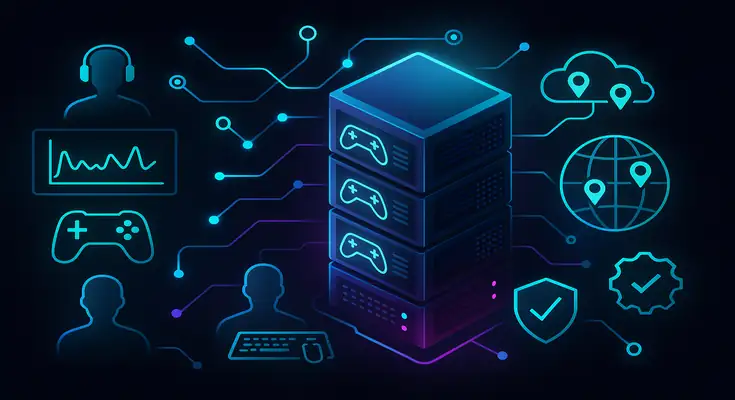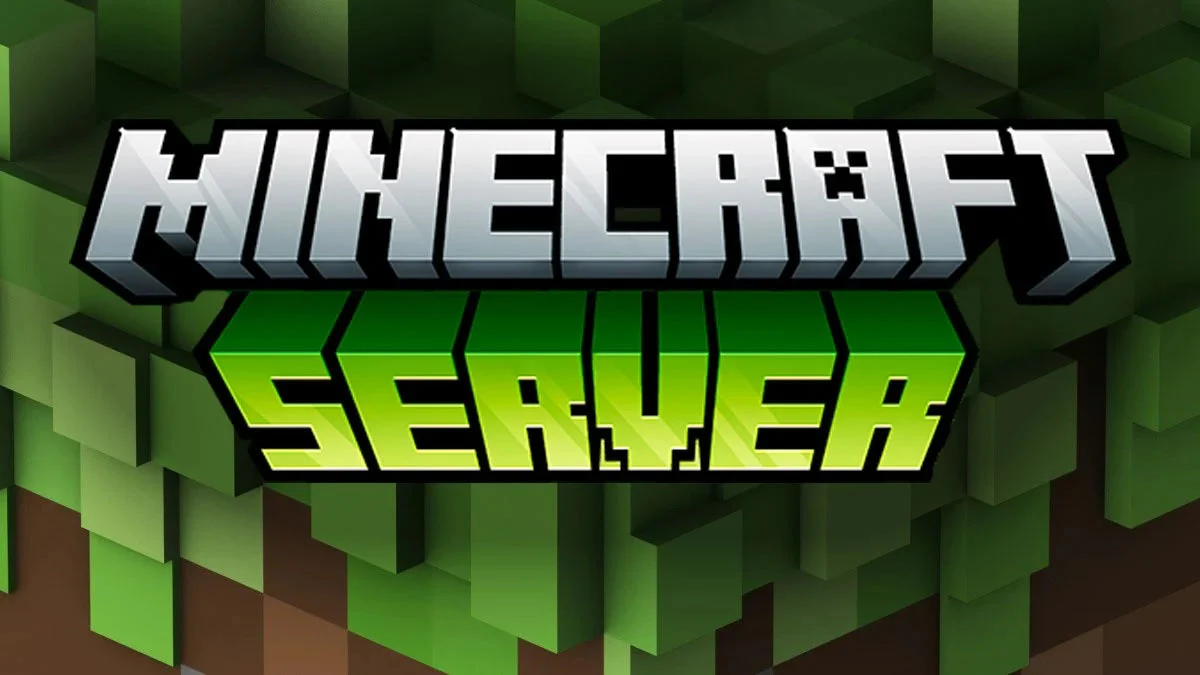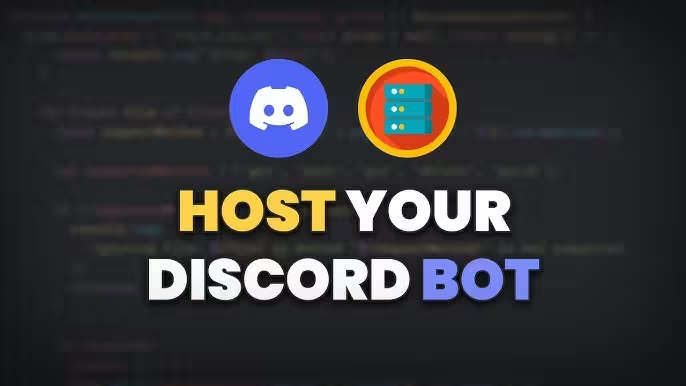What is Game Server Hosting? Gaming Hosting 101 (Part 1)

Game server hosting is a service that provides the infrastructure (hardware, network, software) to run multiplayer game servers 24/7. Unlike playing on official servers, hosting lets you create custom worlds with your own rules, mods, and player base. You can self-host on your PC (free but limited), use shared hosting ($3-15/mo for 10-30 players), or rent dedicated servers ($50+/mo for 100+ players).
Welcome to Gaming Hosting 101 - a beginner-friendly series that explains everything you need to know about game server hosting. Whether you want to play Minecraft with friends, run a FiveM roleplay community, or host a Rust server, this guide series has you covered.
This is Part 1 of 5:
- What is Game Server Hosting? ← You are here
- Types of Game Server Hosting
- Choosing the Right Hosting Plan
- Setting Up Your First Server
- Server Management Best Practices
Let’s start at the beginning: What exactly is game server hosting?
Table of Contents
- Game Servers Explained
- How Game Server Hosting Works
- Why Do You Need Hosting?
- Types of Hosting Overview
- Common Games That Need Hosting
- Key Terminology
- Self-Hosting vs Renting
- Common Misconceptions
- What’s Next
Game Servers Explained
What is a Game Server?
A game server is a computer program that runs continuously to host multiplayer game sessions. Think of it as the “host” of a party - it’s the central place where all players connect to play together.
In Simple Terms:
Your Computer → Internet → Game Server → Internet → Friend's Computer ↓ Game World Lives HereWhen you play multiplayer games, someone needs to run the server software. That “someone” can be:
- 🎮 The game developer (official servers)
- 🏠 You on your own computer (self-hosting)
- 🌐 A hosting company (what this guide is about)
What Does a Game Server Do?
Game servers handle all the “behind-the-scenes” work:
1. Stores the Game World
- Your Minecraft builds
- Rust base locations
- FiveM character data
- Server settings and configurations
2. Processes Player Actions
- Where players move
- What blocks they break/place
- Combat interactions
- Inventory changes
3. Enforces Game Rules
- PvP on or off
- Day/night cycle
- Difficulty settings
- Custom rules/mods
4. Synchronizes Everyone
- Ensures all players see the same world
- Prevents cheating
- Manages player connections
Game Server vs. Playing Solo
Let’s compare:
| Feature | Solo/Local Play | Game Server |
|---|---|---|
| Players | Just you (or local LAN) | Unlimited (within server limits) |
| Always On | Only when you play | 24/7 availability |
| World Persistence | Saves locally | Saved on server, accessible anytime |
| Internet Required | No | Yes |
| Custom Rules | Limited | Full control |
| Mods/Plugins | Personal use only | Everyone uses them |
Example:
- Without Server: You play Minecraft alone. Close game = world stops.
- With Server: 10 friends play on your Minecraft world 24/7, even when you’re offline.
How Game Server Hosting Works
The Technical Side (Simplified)
When you rent game server hosting, here’s what actually happens:
Step 1: The Host Provides Hardware
┌─────────────────────────────────┐│ Physical Server (Computer) ││ • CPU: Processes game logic ││ • RAM: Stores active game data ││ • Storage: Saves world files ││ • Network: Internet connection │└─────────────────────────────────┘Step 2: Game Software is Installed
Hardware → Operating System → Game Server Software → Your WorldStep 3: You Get Access
- Control panel to manage server
- IP address players use to connect
- FTP access to upload/download files
- Console to execute commands
Step 4: Players Connect
Player types: play.yourserver.com:25565 ↓ Connects to server ↓ Joins your game world!What Resources Does a Server Need?
Different games require different resources:
| Resource | What It Does | Example |
|---|---|---|
| CPU | Processes game logic, player actions | Higher for CPU-intensive games (Rust, FiveM) |
| RAM | Stores active world data, player info | More players = more RAM needed |
| Storage | Saves world files, backups, plugins | Grows over time as world expands |
| Network | Handles player connections | Upload speed critical for hosting |
Real-World Example - Minecraft Server:
- 10 players → 2GB RAM, 2 CPU cores, 10GB storage
- 30 players → 4GB RAM, 3 CPU cores, 25GB storage
- 100 players → 16GB RAM, 8 CPU cores, 100GB storage
Why Do You Need Hosting?
The Problem with Not Having a Server
Scenario: You want to play Minecraft with 5 friends.
Option 1: “Open to LAN”
- ❌ Only works if friends are on same local network
- ❌ Your game must be open for others to play
- ❌ Close game = server shuts down
- ❌ Limited player count
- ❌ No access when you’re not playing
Option 2: Host on Your PC
- ❌ Computer must run 24/7 (electricity cost)
- ❌ Performance issues (your PC does double duty)
- ❌ Your home IP is exposed
- ❌ Upload speed likely too slow for many players
- ❌ No professional DDoS protection
Option 3: Use Hosting Service
- ✅ Server runs 24/7 automatically
- ✅ Professional data center connection
- ✅ Dedicated resources (doesn’t affect your PC)
- ✅ DDoS protection included
- ✅ Automatic backups
- ✅ Support when things break
Benefits of Game Server Hosting
1. 24/7 Availability Your world is always online, even when you’re asleep. Players can join anytime.
2. Better Performance
- Dedicated hardware (not competing with your games/apps)
- Data center network (faster than home internet)
- Professional-grade equipment
3. Scalability Start small (10 players) and upgrade as you grow. No hardware purchases needed.
4. Security & Protection
- DDoS protection (attacks won’t take you offline)
- Firewall protection
- Regular security updates
- Isolated environment
5. Reliability
- 99.9% uptime guarantees
- Automatic backups
- Quick recovery from issues
- Professional monitoring
6. Support
- Expert help when things break
- Configuration assistance
- Performance optimization
- Technical troubleshooting
Types of Hosting Overview
We’ll cover these in detail in Part 2, but here’s a quick overview:
1. Self-Hosting (Your PC)
What it is: Running server software on your personal computer.
Cost: Free (except electricity: ~$30-60/mo for 24/7)
Best for: Testing, 2-5 friends, temporary servers
Pros:
- Free software
- Full control
- Learning experience
Cons:
- Requires 24/7 PC
- Your IP exposed
- Home internet limitations
- No professional support
2. Shared Hosting (Budget-Friendly)
What it is: Multiple game servers run on same physical hardware.
Cost: $3-15/month
Best for: Small communities, casual gaming, learning
Pros:
- Affordable
- Easy setup (often 1-click)
- Support included
- No technical knowledge needed
Cons:
- Shared resources (performance can vary)
- Less customization
- Player limits
Popular Providers:
- Mamba Host: $2.99/mo (2GB RAM)
- Shockbyte: $2.50/mo (1GB RAM)
- PebbleHost: $2.50/mo (2GB RAM)
3. VPS Hosting (Virtual Private Server)
What it is: Virtual machine with dedicated resources, more control than shared.
Cost: $10-50/month
Best for: Medium-large servers, multiple games, technical users
Pros:
- Dedicated resources (guaranteed)
- Run multiple servers
- Root access
- Scalable
Cons:
- Requires technical knowledge
- Manual setup (1-4 hours)
- Self-managed
- Linux experience helpful
Popular Providers:
- DigitalOcean: $12/mo (2GB RAM)
- Linode: $12/mo (2GB RAM)
- Vultr: $12/mo (2GB RAM)
4. Dedicated Server (Premium)
What it is: Entire physical server just for you.
Cost: $80-300+/month
Best for: Large networks, 100+ players, serious communities
Pros:
- Maximum performance
- Full control
- No sharing resources
- Enterprise-grade hardware
Cons:
- Expensive
- Requires expertise
- Setup complexity
- Management overhead
Common Games That Need Hosting
Not all games require hosting. Here’s what does and doesn’t:
Games That Need Dedicated Hosting
✅ Minecraft (Java & Bedrock)
- Persistent world needed
- Custom mods/plugins
- 24/7 availability important
- Recommended: 2GB+ RAM per 10 players
✅ FiveM (GTA V Roleplay)
- Roleplay servers require 24/7 uptime
- Heavy resource requirements
- Custom scripts and mods
- Recommended: 4GB+ RAM minimum
✅ Rust
- Large maps, many players
- 24/7 uptime critical
- Weekly wipe schedules
- Recommended: 4GB+ RAM, fast CPU
✅ ARK: Survival Evolved
- Massive worlds
- Persistent taming/building
- High resource requirements
- Recommended: 6GB+ RAM
✅ Terraria
- Persistent world
- Multiplayer building
- Mod support
- Recommended: 1-2GB RAM
✅ Counter-Strike 2
- Competitive matches
- Custom maps/modes
- Community servers
- Recommended: 2GB+ RAM
✅ Valheim
- Large worlds
- Persistent bases
- Co-op gameplay
- Recommended: 4GB+ RAM
Games That DON’T Need Hosting
❌ Call of Duty (Modern Warfare, Warzone)
- Official servers only
- No private hosting available
❌ Fortnite
- Epic Games servers only
- Creative mode on their infrastructure
❌ Valorant
- Riot Games servers only
- No community servers
❌ Overwatch
- Blizzard servers only
- Custom games are temporary
❌ Most Battle Royale Games
- Centralized servers
- No private hosting
💡 Rule of Thumb: If a game has “official servers only” or is a battle royale, you probably can’t host it. Sandbox/survival games usually support private hosting.
Key Terminology
Before diving deeper, let’s define common terms you’ll encounter:
Hardware Terms
CPU (Central Processing Unit)
- The “brain” of the server
- Processes game logic and player actions
- More important than RAM for most games
- Measured in cores and GHz (higher = faster)
RAM (Random Access Memory)
- Temporary storage for active game data
- More players = more RAM needed
- Measured in GB (1GB, 2GB, 4GB, etc.)
- Critical for server performance
Storage (SSD/NVMe)
- Permanent storage for world files, backups
- SSD = Solid State Drive (fast)
- NVMe = Even faster SSD (5-10x faster)
- HDD = Hard Disk Drive (slow, avoid for gaming)
Bandwidth/Network
- Internet connection speed
- Upload speed most important for hosting
- Measured in Mbps or Gbps
- 1Gbps+ recommended for game servers
Server Terms
Slot
- One player connection spot
- “32-slot server” = max 32 players
Uptime
- Percentage of time server is online
- 99.9% uptime = ~45 minutes downtime per month
- Most hosts guarantee 99.9% or higher
Tick Rate (TPS)
- How often server updates game state
- 20 TPS = 20 times per second (Minecraft standard)
- Higher = smoother gameplay
- Affected by server performance
Latency/Ping
- Time for data to travel to/from server
- Measured in milliseconds (ms)
- <50ms = Excellent
- 50-100ms = Good
- 100-150ms = Playable
- 150ms+ = Laggy
Hosting Terms
Control Panel
- Web interface to manage your server
- Start/stop server, edit files, view console
- Examples: Pterodactyl, Multicraft, custom panels
FTP/SFTP
- File Transfer Protocol
- Upload/download files to/from server
- Used for adding mods, backups, etc.
DDoS Protection
- Defense against malicious attacks
- Prevents server from being overwhelmed
- Essential for public servers
Whitelist
- List of approved players
- Only whitelisted players can join
- Common for private servers
Self-Hosting vs Renting
Let’s break down the real costs and considerations:
Self-Hosting on Your PC
Setup:
Your Computer → Port Forwarding → Friends ConnectTrue Monthly Cost:
Electricity: $30-60 (24/7 PC)+ Wear on hardware: $10-20 (depreciation)+ Internet: $0 (already paying)─────────────────────────────────Total: $40-80/month hidden costTime Investment:
Initial Setup: 2-4 hours+ Port Forwarding: 1-2 hours (if first time)+ Troubleshooting: 2-5 hours/month+ Monitoring: Daily checks─────────────────────────────────Total: 10-20 hours first monthPros:
- ✅ No monthly hosting bill (but electricity costs)
- ✅ Complete control
- ✅ Learning experience
- ✅ Direct file access
Cons:
- ❌ $40-80/month in electricity + wear
- ❌ PC must run 24/7 (noise, heat)
- ❌ Home IP exposed (security risk)
- ❌ Limited upload speed (most home: 5-20Mbps)
- ❌ No DDoS protection
- ❌ You’re the support team (2am server crash = your problem)
Renting Shared Hosting
Setup:
Sign Up → Select Plan → Server Deploys (2 minutes) → DoneTrue Monthly Cost:
Hosting: $5-15+ Domain (optional): $1/month─────────────────────────────────Total: $5-16/monthTime Investment:
Initial Setup: 10-30 minutes+ Monthly Management: 1-2 hours─────────────────────────────────Total: 2-3 hours first monthPros:
- ✅ $5-15/month (cheaper than self-hosting electricity)
- ✅ Professional data center (fast internet)
- ✅ DDoS protection included
- ✅ 24/7 uptime (even when you’re offline)
- ✅ Support when things break
- ✅ Automatic backups
Cons:
- ❌ Monthly recurring cost
- ❌ Less control than VPS
- ❌ Shared resources (performance varies)
- ❌ Limited customization
Cost Comparison (First Year)
Self-Hosting:
Electricity: $40/mo × 12 = $480Hardware wear: $120Time: 60 hours × $15/hr = $900 (if you value your time)───────────────────────────────Total: $1,500/yearShared Hosting:
Hosting: $10/mo × 12 = $120Time: 12 hours × $15/hr = $180───────────────────────────────Total: $300/year💡 Reality Check: When you factor in electricity, time, and reliability, renting hosting is usually cheaper and less stressful than self-hosting.
Common Misconceptions
Let’s clear up some myths about game server hosting:
Myth 1: “Hosting is Expensive”
Reality: Shared hosting starts at $3-5/month. That’s less than:
- 🍕 One pizza per month
- ☕ Two coffee shop visits
- 🎮 One AAA game per year
For a dedicated server running 24/7 with professional support, it’s incredibly affordable.
Myth 2: “I Need a Powerful Gaming PC to Host”
Reality: Your gaming PC and game server are separate. You play on your PC, the game world lives on the hosting company’s server. Your PC specs don’t matter for hosting quality.
What Actually Matters:
- Hosting provider’s hardware (CPU, RAM)
- Data center network speed
- Server optimization
Myth 3: “Self-Hosting is Free”
Reality: While the software is free, running your PC 24/7 costs $40-80/month in electricity alone, plus hardware wear. Professional hosting is often cheaper.
Myth 4: “More RAM = Better Performance Always”
Reality: CPU speed matters more than RAM for most games. Bottleneck order:
- CPU (most important for 10+ players)
- Storage Speed (SSD vs HDD makes huge difference)
- RAM (important but often oversold)
- Network (rarely the bottleneck with modern hosts)
Example:
- Bad: 16GB RAM + slow CPU = still laggy
- Good: 4GB RAM + fast CPU = smooth
Myth 5: “All Hosting is the Same, Just Pick Cheapest”
Reality: Hosting quality varies dramatically:
- ❌ Oversold hosts (many servers on weak hardware)
- ❌ Old hardware (HDD instead of SSD)
- ❌ Poor support (24+ hour response times)
- ✅ Quality hosts (dedicated resources, NVMe, fast support)
You Get What You Pay For:
- $2.50/mo host with HDD: Expect lag
- $5-10/mo host with NVMe: Smooth experience
- Difference: Night and day for $2.50 more
Myth 6: “I Need Technical Skills to Host”
Reality: Modern managed hosting is beginner-friendly:
- 1-click game installation
- Web control panel (no command line)
- Pre-configured settings
- Support team helps when stuck
Technical skills only needed for:
- VPS/dedicated hosting
- Advanced customization
- Custom development
For shared hosting: If you can use Facebook, you can manage a game server.
Myth 7: “Unlimited Resources” Offers are Good Deals
Reality: Nothing is truly unlimited. These hosts:
- Oversell servers (cramming too many on one machine)
- Have “fair use” policies (boot you if you actually use resources)
- Performance is usually terrible
Better: Look for hosts with clear, honest resource allocations:
- “2GB RAM” (exact amount)
- “10Gbps network” (specific speed)
- “NVMe storage” (technology specified)
What’s Next in This Series
Now you understand what game server hosting is! Here’s what’s coming in the rest of the series:
Part 2: Types of Game Server Hosting (Coming Next Week)
Deep dive into:
- Shared hosting vs VPS vs Dedicated
- When to use each type
- Cost-benefit analysis
- Provider comparisons
- How to choose for your game
Part 3: Choosing the Right Hosting Plan
Learn how to:
- Calculate required resources (RAM, CPU, storage)
- Match plan to player count
- Evaluate hosting providers
- Spot red flags
- Read reviews effectively
Part 4: Setting Up Your First Server
Step-by-step guide:
- Creating your first server
- Installing mods/plugins
- Configuring settings
- Inviting players
- Troubleshooting common issues
Part 5: Server Management Best Practices
Master the ongoing work:
- Daily/weekly maintenance tasks
- Performance optimization
- Backup strategies
- Security best practices
- Community management
Quick Reference: Do You Need Hosting?
Use this flowchart to decide:
Do you want to play with others online? └─ No → Play solo, no hosting needed └─ Yes → Continue ↓
Will friends join only when you're online? └─ Yes → Use "Open to LAN" or self-host temporarily └─ No → Continue ↓
Do you want 24/7 uptime? └─ No → Self-host on your PC (save money) └─ Yes → Continue ↓
Is your budget under $5/month? └─ Yes → Use free hosting (limited) or wait └─ No → Continue ↓
Do you want easy setup with support? └─ Yes → Use shared hosting ($5-15/mo) ✅ BEST FOR MOST └─ No → Use VPS if technical ($10-50/mo)
Will you have 100+ players? └─ Yes → Use dedicated server ($80+/mo) └─ No → Shared hosting perfectReal-World Examples
Example 1: Small Minecraft Server (10 Friends)
Needs:
- 10 player slots
- 24/7 uptime (friends in different time zones)
- A few plugins (EssentialsX, WorldEdit)
- Don’t want to self-host
Solution:
- Shared hosting: $5-8/month
- 2GB RAM plan
- Mamba Host or similar provider
- Total cost: $60-96/year
Why not self-host?
- Electricity alone: $40/mo × 12 = $480/year
- Plus hardware wear, time, hassle
- Savings with hosting: $384-420/year + peace of mind
Example 2: Medium FiveM RP Server (32 Players)
Needs:
- 32 player slots
- ESX framework with 100+ resources
- 24/7 uptime (roleplay server)
- MySQL database
- Strong CPU (FiveM is CPU-intensive)
Solution:
- Shared hosting with FiveM focus: $20-30/month
- 6-8GB RAM plan
- Managed FiveM host (txAdmin pre-installed)
- Total cost: $240-360/year
Why not VPS?
- Setup time: 4-6 hours vs 10 minutes
- Technical knowledge required
- No FiveM-specific support
- Price similar anyway
Example 3: Large Rust Server Network (200+ Players)
Needs:
- 200+ player capacity
- Multiple servers (2-3 Rust servers)
- Custom plugins
- 24/7 monitoring
- High performance (Rust is demanding)
Solution:
- Dedicated server: $150-200/month
- Self-managed VPS alternative: $80-100/month
- Full control for custom setup
- Total cost: $960-2,400/year
Why not shared hosting?
- 200+ players exceed shared hosting capacity
- Need dedicated CPU cores
- Performance is critical
- Worth the premium for quality
Getting Started Checklist
Ready to start your hosting journey? Use this checklist:
Before You Buy:
- Decide what game you’re hosting
- Estimate player count (start small, scale up)
- Calculate budget (be realistic)
- Research 3-5 hosting providers
- Read recent reviews (Reddit, Trustpilot)
- Check money-back guarantee period
When Choosing Provider:
- Verify hardware specs (CPU model, storage type)
- Check support hours (24/7 vs business hours)
- Test support (send pre-sale question)
- Compare prices (but don’t pick cheapest by default)
- Verify DDoS protection included
- Check refund policy
After Purchase:
- Set up account and server
- Test server performance
- Install plugins/mods
- Create test world
- Invite friends to test
- Monitor performance first 48 hours
- Request refund if not satisfied (within guarantee period)
Key Takeaways
Before moving to Part 2, remember these essentials:
1. What is Game Server Hosting? Service providing hardware, software, and network to run multiplayer game servers 24/7.
2. Why Use It?
- 24/7 availability
- Better performance than home PC
- Professional infrastructure
- Support when needed
- Often cheaper than self-hosting
3. Types Overview:
- Shared Hosting: $5-15/mo, best for most users
- VPS: $10-50/mo, technical users
- Dedicated: $80+/mo, large communities
- Self-Host: “Free” but costs $40-80/mo in electricity
4. Main Factors:
- CPU matters most (not just RAM)
- NVMe storage 5-10x faster than HDD
- Support quality saves time and frustration
- Uptime guarantee (99.9% minimum)
5. Common Games: Minecraft, FiveM, Rust, ARK, Terraria, CS2 all benefit from dedicated hosting.
What Questions Do You Have?
Game server hosting might seem complex, but it doesn’t have to be. In Part 2, we’ll break down the different types of hosting in detail, helping you choose the right option for your needs and budget.
Have questions about this guide? Join our Discord community where beginners and experts help each other, or contact our team for personalized advice.
Ready to get started? Try our hosting with zero risk:
- Minecraft Hosting - Starting at $2.99/mo
- FiveM Hosting - Starting at $14.99/mo
- All Games - See full lineup
Up Next: Part 2
Types of Game Server Hosting Deep Dive
We’ll cover:
- Shared hosting explained (pros, cons, when to use)
- VPS hosting breakdown (setup, management, costs)
- Dedicated servers (overkill or necessary?)
- Cloud gaming hosting (AWS, GCP for games?)
- Provider comparison by type
- Decision framework for your situation
Series Progress: ████░░░░░░ 1 of 5 complete
Next: Part 2: Types of Game Server Hosting →
Last updated: October 24, 2025 Part of Gaming Hosting 101 Series Target audience: Complete beginners to game server hosting


